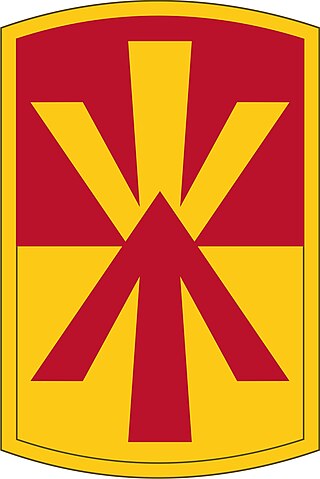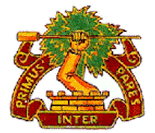
The 4th Air Defense Artillery Regiment was constituted 1 June 1821 in the Regular Army as the 4th Regiment of Artillery and organized from new and existing units with headquarters at Pensacola, Florida. As a result of the division of the Artillery Corps into Coast and Field Artillery units, the Regiment was broken up 13 February 1901, and its elements reorganized and redesignated as separate numbered companies and batteries of the Artillery Corps.

The 11th Air Defense Artillery Brigade is an air defense artillery brigade of the United States Army stationed at Fort Bliss.

The 1st Air Defense Artillery is an air defense artillery regiment in the United States Army first formed as a field artillery unit in 1821.

The 2nd Air Defense Artillery Regiment is an air defense artillery regiment of the United States Army, first formed in 1821 as a field artillery unit.

The 5th Air Defense Artillery Regiment is an Air Defense Artillery regiment of the United States Army, first formed in 1861 in the Regular Army as the 5th Regiment of Artillery.

The 3rd Air Defense Artillery Regiment is an air defense artillery regiment of the United States Army, first formed in 1821 as the 3rd Regiment of Artillery.

The 7th Air Defense Artillery Regiment is an air defense artillery regiment of the United States Army, first constituted in the Regular Army as the 7th Regiment of Artillery on 8 March 1898. The 6th and 7th U.S. Artillery Regiments were constituted on 8 March 1898, three weeks after the explosion of USS Maine in Havana, Cuba on 15 February 1898, as the United States' declaration of war on Spain and commencement of the Spanish–American War seemed imminent.

The 6th Air Defense Artillery Regiment is an air defense artillery regiment in the United States Army, first formed in 1898 as the 6th Regiment of Artillery. The 6th and 7th U.S. Artillery Regiments were constituted on 8 March 1898, three weeks after the explosion of the USS Maine in Havana, Cuba on 15 February 1898, as the United States' declaration of war on Spain and commencement of the Spanish–American War seemed imminent.
The 8th Coast Artillery Regiment was a Coast Artillery Corps regiment in the United States Army, which garrisoned the Harbor Defenses of Portland, Maine 1924–1944, and the Harbor Defenses of Portsmouth, New Hampshire 1924–1940.
The 9th Coast Artillery Regiment was a Coast Artillery regiment in the United States Army.
The 10th Coast Artillery Regiment was a Coast Artillery regiment in the United States Army. It primarily served as the Regular Army coast artillery component of the Harbor Defenses (HD) of Narragansett Bay, Rhode Island from 1924 through 1944, when it was relieved and disbanded as part of an Army-wide reorganization.
The 12th Coast Artillery Regiment was a Coast Artillery regiment in the United States Army, constituted in the Regular Army on 27 February 1924. It served in the Harbor Defenses of the Chesapeake with headquarters at Fort Monroe, Virginia from 1924 to 1932. At that point, the regiment effectively became the 2nd Coast Artillery; on paper the 2nd Coast Artillery was transferred from the Harbor Defenses of Cristobal in the Panama Canal Zone and the 12th was transferred to that harbor defense. However, the 12th was never activated again, and on 19 June 1944 was disbanded.
The 13th Coast Artillery Regiment was a Coast Artillery regiment in the United States Army. Elements of the regiment served during World War II in the Harbor Defenses of Pensacola, HD Key West, HD Galveston, HD Charleston, Temporary HD of New Orleans, and in Bora Bora in the South Pacific. The regiment was broken up and its elements redesignated on 31 August 1944 as part of an Army-wide reorganization.
The 14th Coast Artillery Regiment was a Coast Artillery regiment in the United States Army. It served as the Regular Army component of the Harbor Defenses (HD) of Puget Sound, Washington state from 1924 through October 1944, when it was broken up and disbanded as part of an Army-wide reorganization. The 248th Coast Artillery Regiment was the Washington National Guard component of those defenses.

The 15th Coast Artillery was a Coast Artillery Corps regiment in the United States Army. Along with the 16th Coast Artillery, it manned the Harbor Defenses of Pearl Harbor and other fortified sites on Oahu, Hawaii from 1924 until broken up into battalions in August 1944 as part of an Army-wide reorganization.
The 16th Coast Artillery Regiment was a Coast Artillery regiment in the United States Army, along with the 15th Coast Artillery, it manned the Harbor Defenses of Honolulu and other fortified sites on Oahu, Hawaii from 1924 until broken up into battalions in August 1944 as part of an Army-wide reorganization. The regiment manned many gun batteries at locations all over Oahu. Most of the forts where they were assigned were originally built 1899–1910, and had been in caretaker status for more than 30 years. On the morning of 7 December 1941, the soldiers of the 16th Coast Artillery manned their anti-aircraft guns, bringing down six of the attacking Japanese aircraft.

The 51st Coast Artillery Regiment was a Coast Artillery regiment in the United States Army.
The 53rd Coast Artillery Regiment was a Coast Artillery regiment in the United States Army. In World War I it was a railway artillery regiment in France. In World War II it was reactivated with mobile 155 mm guns.
The 251st Coast Artillery was a coast artillery regiment in the California National Guard, constituted in 1924 as a harbor defense regiment for the 9th Artillery District and re-designated in 1930 as an antiaircraft regiment. It served in World War II in that capacity.

The 265th Air Defense Artillery Regiment is an air defense artillery regiment in the Florida Army National Guard. The unit was formed 19 October 1923 in the Florida National Guard as the 1st Separate Battalion, Coast Artillery Corps. It was reorganized and redesignated as the 265th Coast Artillery Regiment (CA) (HD) in 1929. The 265th was activated for World War II and served in the harbor defenses of Galveston, Texas, Los Angeles, California, Key West, Florida, Sandy Hook, New Jersey, and Alaska until broken up into battalions in July 1944. The unit lineage was carried by two antiaircraft battalions organized in 1946, one of which was federalized in Florida during the Korean War. Consolidated with other units in 1959 as the 265th Artillery; reorganized in 1987 as the 265th Air Defense Artillery.











